Analyzing Identity: Japanese-Canadian Culture, History, and Film
VerifiedAdded on 2023/06/12
|7
|1937
|78
Essay
AI Summary
This essay delves into the evolving identities of Japanese-Canadians, particularly focusing on the impacts of intermarriage and cultural integration. It examines how the film 'One Big Hapa Family' contributes to understanding the history and culture of this community, highlighting the high rates of intermarriage and their implications on language, cultural heritage, and societal perceptions. The essay traces the historical context from the Issei generation to the Yonsei, analyzing how discrimination, social infrastructure destruction, and changing cultural norms have influenced intermarriage rates. It further discusses the effects on the educational system, the redefining of cultural perspectives, and the evolving language dynamics within Japanese-Canadian families, ultimately emphasizing the contribution of multiculturalism to Canada's economic and cultural landscape. The essay concludes that intermarriage has significantly reshaped the Japanese culture and language in Canada, challenging traditional definitions of culture based on ethnicity or language.
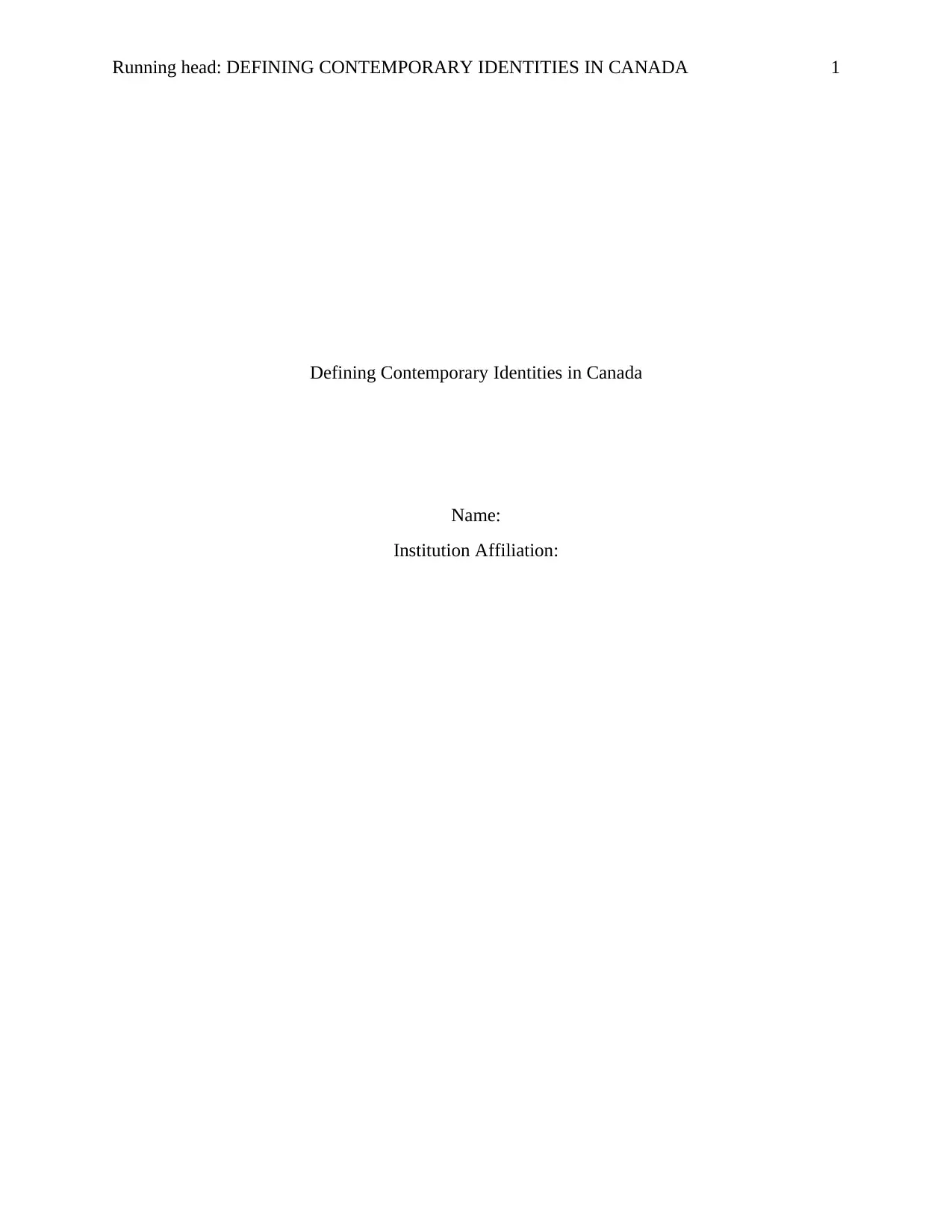
Running head: DEFINING CONTEMPORARY IDENTITIES IN CANADA 1
Defining Contemporary Identities in Canada
Name:
Institution Affiliation:
Defining Contemporary Identities in Canada
Name:
Institution Affiliation:
Paraphrase This Document
Need a fresh take? Get an instant paraphrase of this document with our AI Paraphraser
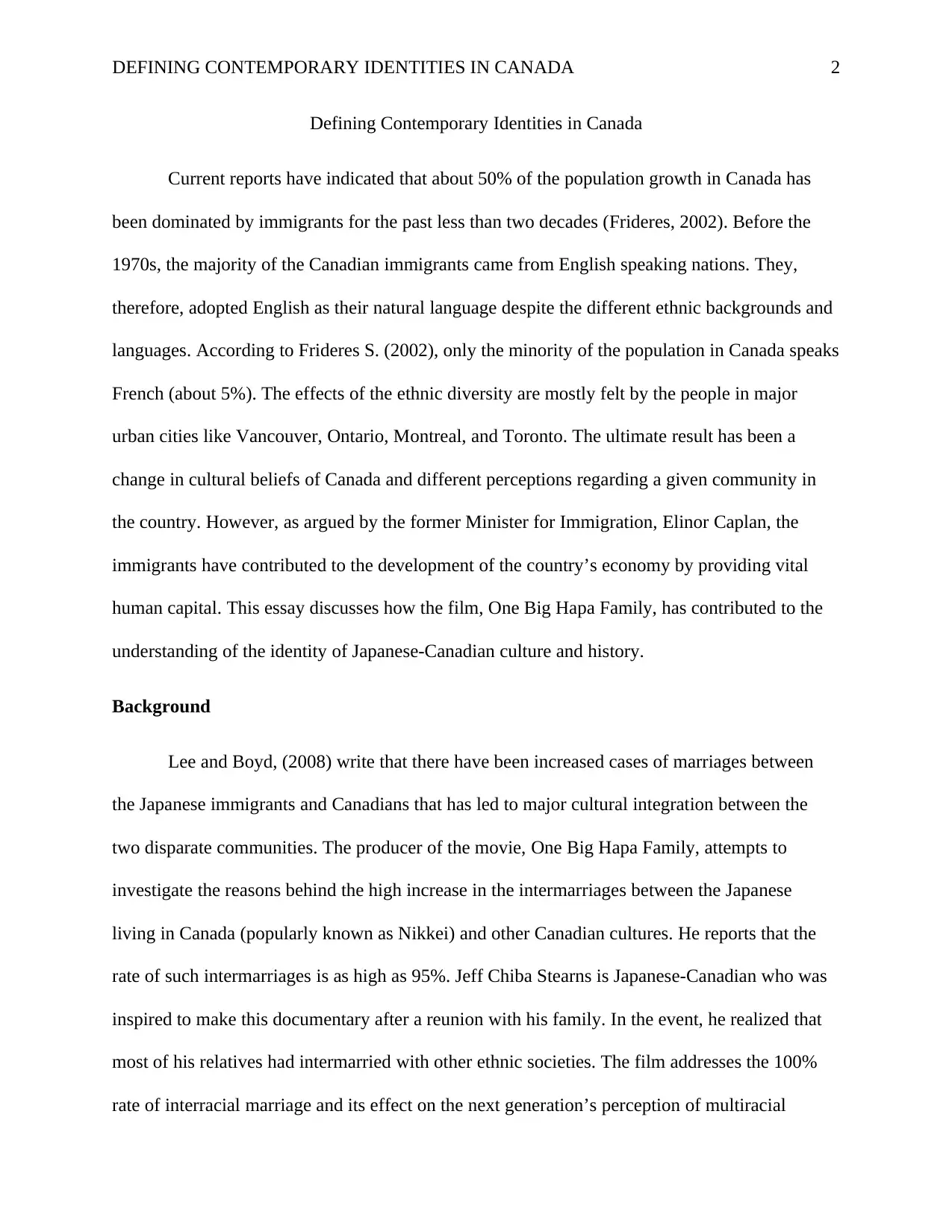
DEFINING CONTEMPORARY IDENTITIES IN CANADA 2
Defining Contemporary Identities in Canada
Current reports have indicated that about 50% of the population growth in Canada has
been dominated by immigrants for the past less than two decades (Frideres, 2002). Before the
1970s, the majority of the Canadian immigrants came from English speaking nations. They,
therefore, adopted English as their natural language despite the different ethnic backgrounds and
languages. According to Frideres S. (2002), only the minority of the population in Canada speaks
French (about 5%). The effects of the ethnic diversity are mostly felt by the people in major
urban cities like Vancouver, Ontario, Montreal, and Toronto. The ultimate result has been a
change in cultural beliefs of Canada and different perceptions regarding a given community in
the country. However, as argued by the former Minister for Immigration, Elinor Caplan, the
immigrants have contributed to the development of the country’s economy by providing vital
human capital. This essay discusses how the film, One Big Hapa Family, has contributed to the
understanding of the identity of Japanese-Canadian culture and history.
Background
Lee and Boyd, (2008) write that there have been increased cases of marriages between
the Japanese immigrants and Canadians that has led to major cultural integration between the
two disparate communities. The producer of the movie, One Big Hapa Family, attempts to
investigate the reasons behind the high increase in the intermarriages between the Japanese
living in Canada (popularly known as Nikkei) and other Canadian cultures. He reports that the
rate of such intermarriages is as high as 95%. Jeff Chiba Stearns is Japanese-Canadian who was
inspired to make this documentary after a reunion with his family. In the event, he realized that
most of his relatives had intermarried with other ethnic societies. The film addresses the 100%
rate of interracial marriage and its effect on the next generation’s perception of multiracial
Defining Contemporary Identities in Canada
Current reports have indicated that about 50% of the population growth in Canada has
been dominated by immigrants for the past less than two decades (Frideres, 2002). Before the
1970s, the majority of the Canadian immigrants came from English speaking nations. They,
therefore, adopted English as their natural language despite the different ethnic backgrounds and
languages. According to Frideres S. (2002), only the minority of the population in Canada speaks
French (about 5%). The effects of the ethnic diversity are mostly felt by the people in major
urban cities like Vancouver, Ontario, Montreal, and Toronto. The ultimate result has been a
change in cultural beliefs of Canada and different perceptions regarding a given community in
the country. However, as argued by the former Minister for Immigration, Elinor Caplan, the
immigrants have contributed to the development of the country’s economy by providing vital
human capital. This essay discusses how the film, One Big Hapa Family, has contributed to the
understanding of the identity of Japanese-Canadian culture and history.
Background
Lee and Boyd, (2008) write that there have been increased cases of marriages between
the Japanese immigrants and Canadians that has led to major cultural integration between the
two disparate communities. The producer of the movie, One Big Hapa Family, attempts to
investigate the reasons behind the high increase in the intermarriages between the Japanese
living in Canada (popularly known as Nikkei) and other Canadian cultures. He reports that the
rate of such intermarriages is as high as 95%. Jeff Chiba Stearns is Japanese-Canadian who was
inspired to make this documentary after a reunion with his family. In the event, he realized that
most of his relatives had intermarried with other ethnic societies. The film addresses the 100%
rate of interracial marriage and its effect on the next generation’s perception of multiracial
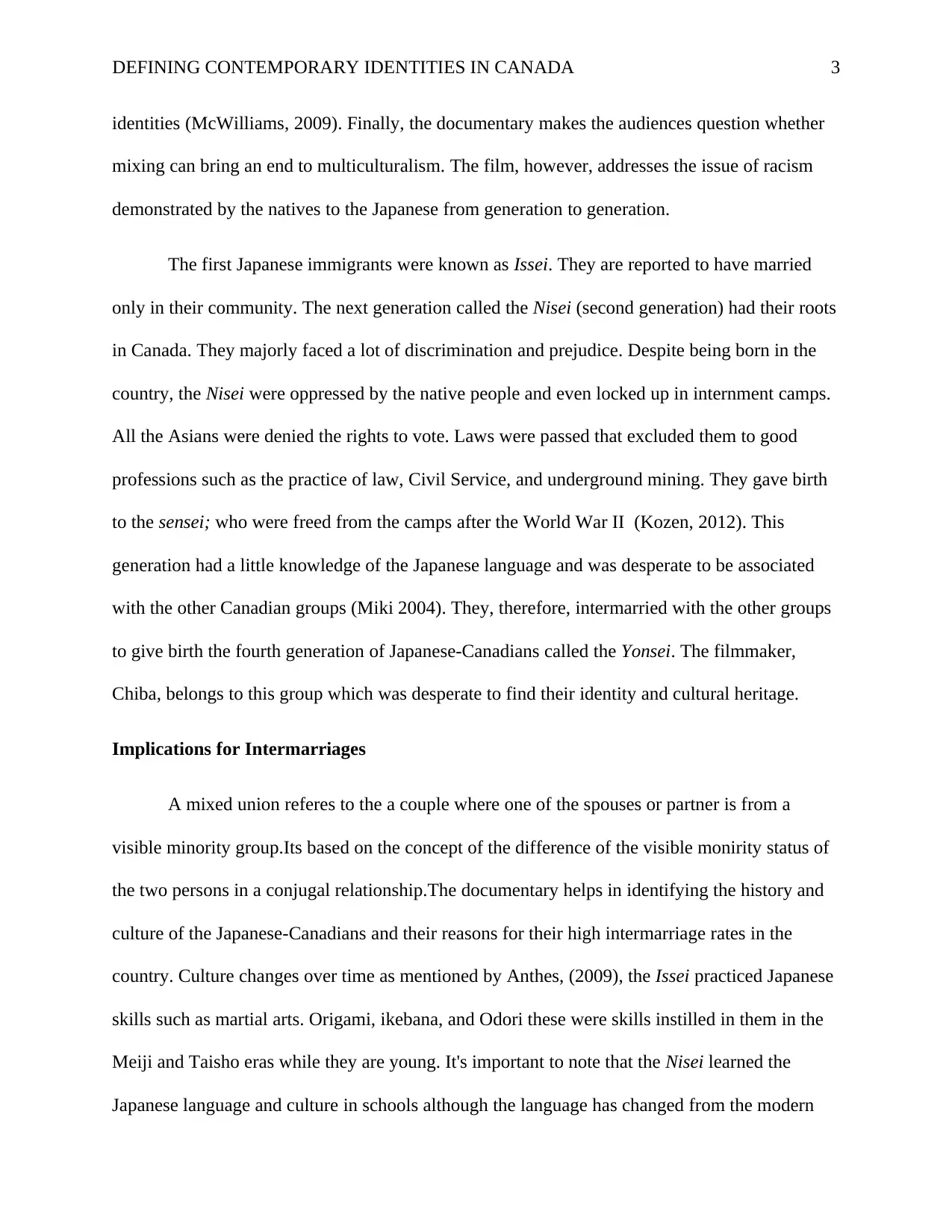
DEFINING CONTEMPORARY IDENTITIES IN CANADA 3
identities (McWilliams, 2009). Finally, the documentary makes the audiences question whether
mixing can bring an end to multiculturalism. The film, however, addresses the issue of racism
demonstrated by the natives to the Japanese from generation to generation.
The first Japanese immigrants were known as Issei. They are reported to have married
only in their community. The next generation called the Nisei (second generation) had their roots
in Canada. They majorly faced a lot of discrimination and prejudice. Despite being born in the
country, the Nisei were oppressed by the native people and even locked up in internment camps.
All the Asians were denied the rights to vote. Laws were passed that excluded them to good
professions such as the practice of law, Civil Service, and underground mining. They gave birth
to the sensei; who were freed from the camps after the World War II (Kozen, 2012). This
generation had a little knowledge of the Japanese language and was desperate to be associated
with the other Canadian groups (Miki 2004). They, therefore, intermarried with the other groups
to give birth the fourth generation of Japanese-Canadians called the Yonsei. The filmmaker,
Chiba, belongs to this group which was desperate to find their identity and cultural heritage.
Implications for Intermarriages
A mixed union referes to the a couple where one of the spouses or partner is from a
visible minority group.Its based on the concept of the difference of the visible monirity status of
the two persons in a conjugal relationship.The documentary helps in identifying the history and
culture of the Japanese-Canadians and their reasons for their high intermarriage rates in the
country. Culture changes over time as mentioned by Anthes, (2009), the Issei practiced Japanese
skills such as martial arts. Origami, ikebana, and Odori these were skills instilled in them in the
Meiji and Taisho eras while they are young. It's important to note that the Nisei learned the
Japanese language and culture in schools although the language has changed from the modern
identities (McWilliams, 2009). Finally, the documentary makes the audiences question whether
mixing can bring an end to multiculturalism. The film, however, addresses the issue of racism
demonstrated by the natives to the Japanese from generation to generation.
The first Japanese immigrants were known as Issei. They are reported to have married
only in their community. The next generation called the Nisei (second generation) had their roots
in Canada. They majorly faced a lot of discrimination and prejudice. Despite being born in the
country, the Nisei were oppressed by the native people and even locked up in internment camps.
All the Asians were denied the rights to vote. Laws were passed that excluded them to good
professions such as the practice of law, Civil Service, and underground mining. They gave birth
to the sensei; who were freed from the camps after the World War II (Kozen, 2012). This
generation had a little knowledge of the Japanese language and was desperate to be associated
with the other Canadian groups (Miki 2004). They, therefore, intermarried with the other groups
to give birth the fourth generation of Japanese-Canadians called the Yonsei. The filmmaker,
Chiba, belongs to this group which was desperate to find their identity and cultural heritage.
Implications for Intermarriages
A mixed union referes to the a couple where one of the spouses or partner is from a
visible minority group.Its based on the concept of the difference of the visible monirity status of
the two persons in a conjugal relationship.The documentary helps in identifying the history and
culture of the Japanese-Canadians and their reasons for their high intermarriage rates in the
country. Culture changes over time as mentioned by Anthes, (2009), the Issei practiced Japanese
skills such as martial arts. Origami, ikebana, and Odori these were skills instilled in them in the
Meiji and Taisho eras while they are young. It's important to note that the Nisei learned the
Japanese language and culture in schools although the language has changed from the modern
⊘ This is a preview!⊘
Do you want full access?
Subscribe today to unlock all pages.

Trusted by 1+ million students worldwide
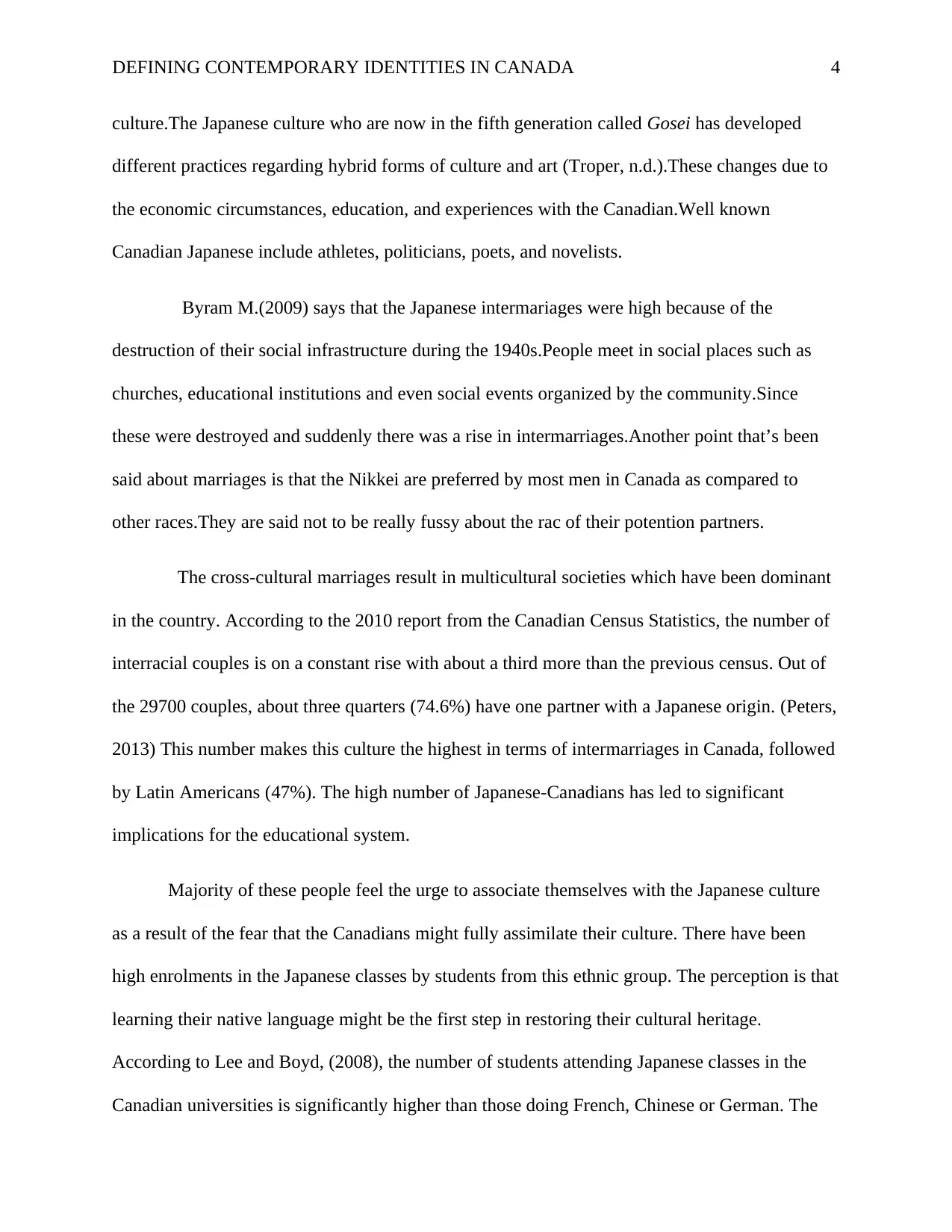
DEFINING CONTEMPORARY IDENTITIES IN CANADA 4
culture.The Japanese culture who are now in the fifth generation called Gosei has developed
different practices regarding hybrid forms of culture and art (Troper, n.d.).These changes due to
the economic circumstances, education, and experiences with the Canadian.Well known
Canadian Japanese include athletes, politicians, poets, and novelists.
Byram M.(2009) says that the Japanese intermariages were high because of the
destruction of their social infrastructure during the 1940s.People meet in social places such as
churches, educational institutions and even social events organized by the community.Since
these were destroyed and suddenly there was a rise in intermarriages.Another point that’s been
said about marriages is that the Nikkei are preferred by most men in Canada as compared to
other races.They are said not to be really fussy about the rac of their potention partners.
The cross-cultural marriages result in multicultural societies which have been dominant
in the country. According to the 2010 report from the Canadian Census Statistics, the number of
interracial couples is on a constant rise with about a third more than the previous census. Out of
the 29700 couples, about three quarters (74.6%) have one partner with a Japanese origin. (Peters,
2013) This number makes this culture the highest in terms of intermarriages in Canada, followed
by Latin Americans (47%). The high number of Japanese-Canadians has led to significant
implications for the educational system.
Majority of these people feel the urge to associate themselves with the Japanese culture
as a result of the fear that the Canadians might fully assimilate their culture. There have been
high enrolments in the Japanese classes by students from this ethnic group. The perception is that
learning their native language might be the first step in restoring their cultural heritage.
According to Lee and Boyd, (2008), the number of students attending Japanese classes in the
Canadian universities is significantly higher than those doing French, Chinese or German. The
culture.The Japanese culture who are now in the fifth generation called Gosei has developed
different practices regarding hybrid forms of culture and art (Troper, n.d.).These changes due to
the economic circumstances, education, and experiences with the Canadian.Well known
Canadian Japanese include athletes, politicians, poets, and novelists.
Byram M.(2009) says that the Japanese intermariages were high because of the
destruction of their social infrastructure during the 1940s.People meet in social places such as
churches, educational institutions and even social events organized by the community.Since
these were destroyed and suddenly there was a rise in intermarriages.Another point that’s been
said about marriages is that the Nikkei are preferred by most men in Canada as compared to
other races.They are said not to be really fussy about the rac of their potention partners.
The cross-cultural marriages result in multicultural societies which have been dominant
in the country. According to the 2010 report from the Canadian Census Statistics, the number of
interracial couples is on a constant rise with about a third more than the previous census. Out of
the 29700 couples, about three quarters (74.6%) have one partner with a Japanese origin. (Peters,
2013) This number makes this culture the highest in terms of intermarriages in Canada, followed
by Latin Americans (47%). The high number of Japanese-Canadians has led to significant
implications for the educational system.
Majority of these people feel the urge to associate themselves with the Japanese culture
as a result of the fear that the Canadians might fully assimilate their culture. There have been
high enrolments in the Japanese classes by students from this ethnic group. The perception is that
learning their native language might be the first step in restoring their cultural heritage.
According to Lee and Boyd, (2008), the number of students attending Japanese classes in the
Canadian universities is significantly higher than those doing French, Chinese or German. The
Paraphrase This Document
Need a fresh take? Get an instant paraphrase of this document with our AI Paraphraser
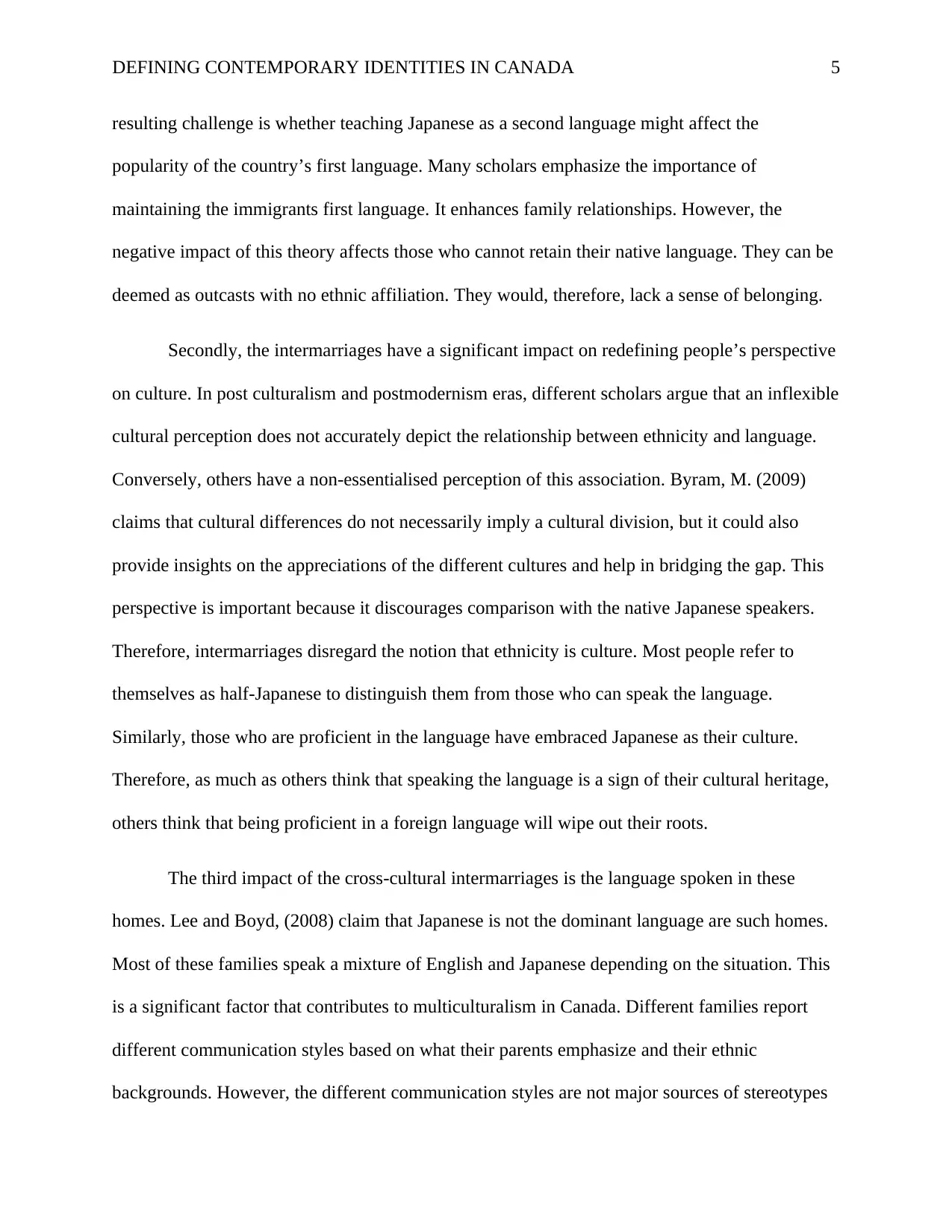
DEFINING CONTEMPORARY IDENTITIES IN CANADA 5
resulting challenge is whether teaching Japanese as a second language might affect the
popularity of the country’s first language. Many scholars emphasize the importance of
maintaining the immigrants first language. It enhances family relationships. However, the
negative impact of this theory affects those who cannot retain their native language. They can be
deemed as outcasts with no ethnic affiliation. They would, therefore, lack a sense of belonging.
Secondly, the intermarriages have a significant impact on redefining people’s perspective
on culture. In post culturalism and postmodernism eras, different scholars argue that an inflexible
cultural perception does not accurately depict the relationship between ethnicity and language.
Conversely, others have a non-essentialised perception of this association. Byram, M. (2009)
claims that cultural differences do not necessarily imply a cultural division, but it could also
provide insights on the appreciations of the different cultures and help in bridging the gap. This
perspective is important because it discourages comparison with the native Japanese speakers.
Therefore, intermarriages disregard the notion that ethnicity is culture. Most people refer to
themselves as half-Japanese to distinguish them from those who can speak the language.
Similarly, those who are proficient in the language have embraced Japanese as their culture.
Therefore, as much as others think that speaking the language is a sign of their cultural heritage,
others think that being proficient in a foreign language will wipe out their roots.
The third impact of the cross-cultural intermarriages is the language spoken in these
homes. Lee and Boyd, (2008) claim that Japanese is not the dominant language are such homes.
Most of these families speak a mixture of English and Japanese depending on the situation. This
is a significant factor that contributes to multiculturalism in Canada. Different families report
different communication styles based on what their parents emphasize and their ethnic
backgrounds. However, the different communication styles are not major sources of stereotypes
resulting challenge is whether teaching Japanese as a second language might affect the
popularity of the country’s first language. Many scholars emphasize the importance of
maintaining the immigrants first language. It enhances family relationships. However, the
negative impact of this theory affects those who cannot retain their native language. They can be
deemed as outcasts with no ethnic affiliation. They would, therefore, lack a sense of belonging.
Secondly, the intermarriages have a significant impact on redefining people’s perspective
on culture. In post culturalism and postmodernism eras, different scholars argue that an inflexible
cultural perception does not accurately depict the relationship between ethnicity and language.
Conversely, others have a non-essentialised perception of this association. Byram, M. (2009)
claims that cultural differences do not necessarily imply a cultural division, but it could also
provide insights on the appreciations of the different cultures and help in bridging the gap. This
perspective is important because it discourages comparison with the native Japanese speakers.
Therefore, intermarriages disregard the notion that ethnicity is culture. Most people refer to
themselves as half-Japanese to distinguish them from those who can speak the language.
Similarly, those who are proficient in the language have embraced Japanese as their culture.
Therefore, as much as others think that speaking the language is a sign of their cultural heritage,
others think that being proficient in a foreign language will wipe out their roots.
The third impact of the cross-cultural intermarriages is the language spoken in these
homes. Lee and Boyd, (2008) claim that Japanese is not the dominant language are such homes.
Most of these families speak a mixture of English and Japanese depending on the situation. This
is a significant factor that contributes to multiculturalism in Canada. Different families report
different communication styles based on what their parents emphasize and their ethnic
backgrounds. However, the different communication styles are not major sources of stereotypes
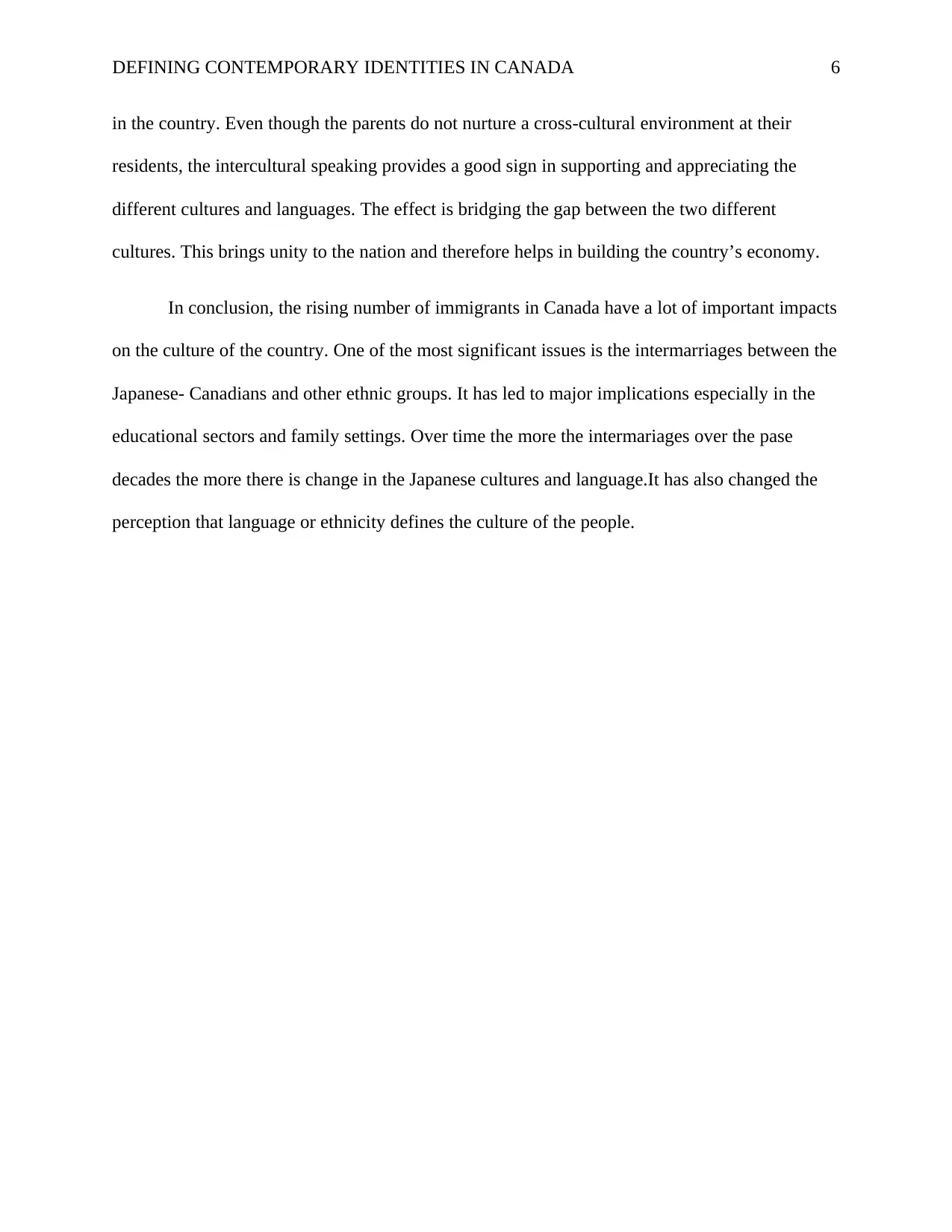
DEFINING CONTEMPORARY IDENTITIES IN CANADA 6
in the country. Even though the parents do not nurture a cross-cultural environment at their
residents, the intercultural speaking provides a good sign in supporting and appreciating the
different cultures and languages. The effect is bridging the gap between the two different
cultures. This brings unity to the nation and therefore helps in building the country’s economy.
In conclusion, the rising number of immigrants in Canada have a lot of important impacts
on the culture of the country. One of the most significant issues is the intermarriages between the
Japanese- Canadians and other ethnic groups. It has led to major implications especially in the
educational sectors and family settings. Over time the more the intermariages over the pase
decades the more there is change in the Japanese cultures and language.It has also changed the
perception that language or ethnicity defines the culture of the people.
in the country. Even though the parents do not nurture a cross-cultural environment at their
residents, the intercultural speaking provides a good sign in supporting and appreciating the
different cultures and languages. The effect is bridging the gap between the two different
cultures. This brings unity to the nation and therefore helps in building the country’s economy.
In conclusion, the rising number of immigrants in Canada have a lot of important impacts
on the culture of the country. One of the most significant issues is the intermarriages between the
Japanese- Canadians and other ethnic groups. It has led to major implications especially in the
educational sectors and family settings. Over time the more the intermariages over the pase
decades the more there is change in the Japanese cultures and language.It has also changed the
perception that language or ethnicity defines the culture of the people.
⊘ This is a preview!⊘
Do you want full access?
Subscribe today to unlock all pages.

Trusted by 1+ million students worldwide
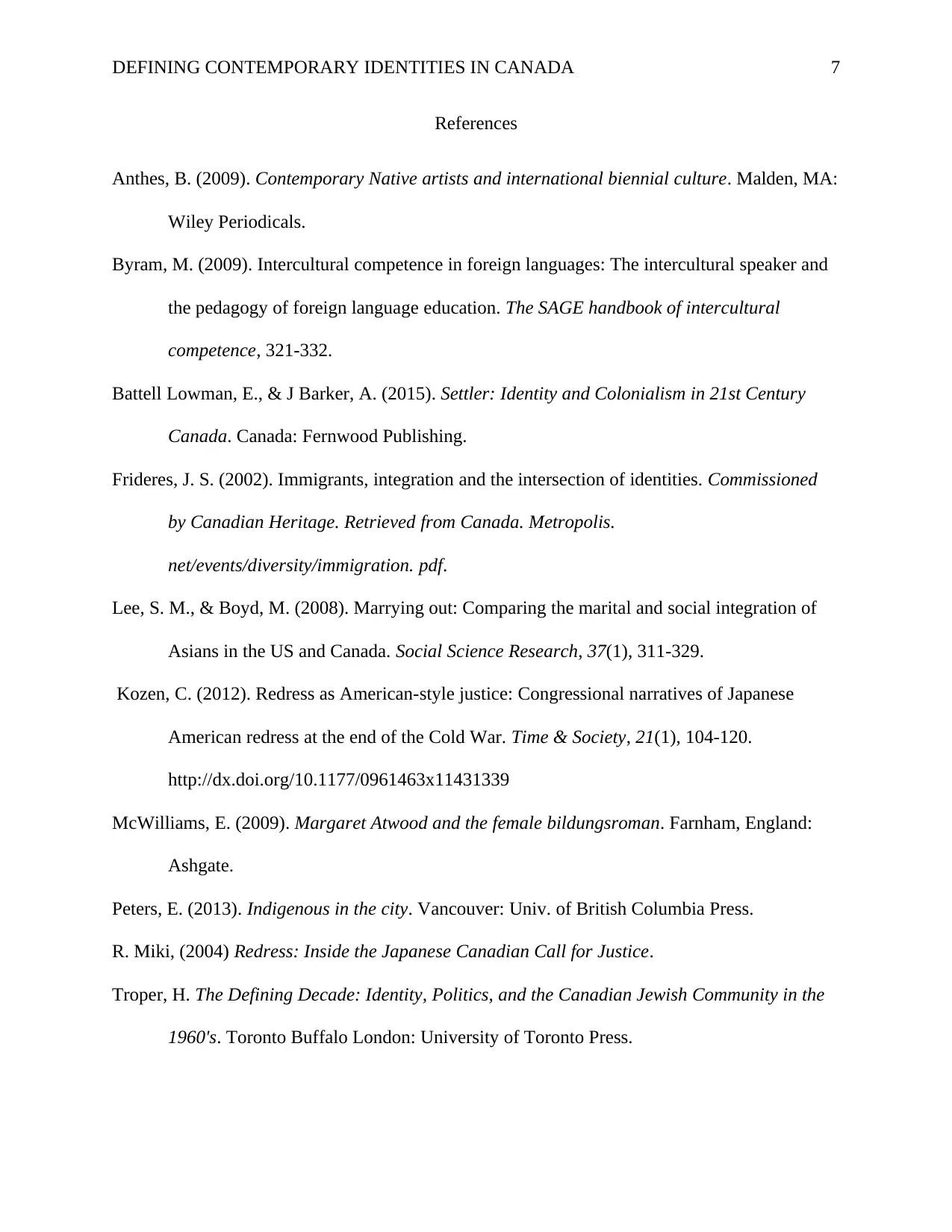
DEFINING CONTEMPORARY IDENTITIES IN CANADA 7
References
Anthes, B. (2009). Contemporary Native artists and international biennial culture. Malden, MA:
Wiley Periodicals.
Byram, M. (2009). Intercultural competence in foreign languages: The intercultural speaker and
the pedagogy of foreign language education. The SAGE handbook of intercultural
competence, 321-332.
Battell Lowman, E., & J Barker, A. (2015). Settler: Identity and Colonialism in 21st Century
Canada. Canada: Fernwood Publishing.
Frideres, J. S. (2002). Immigrants, integration and the intersection of identities. Commissioned
by Canadian Heritage. Retrieved from Canada. Metropolis.
net/events/diversity/immigration. pdf.
Lee, S. M., & Boyd, M. (2008). Marrying out: Comparing the marital and social integration of
Asians in the US and Canada. Social Science Research, 37(1), 311-329.
Kozen, C. (2012). Redress as American-style justice: Congressional narratives of Japanese
American redress at the end of the Cold War. Time & Society, 21(1), 104-120.
http://dx.doi.org/10.1177/0961463x11431339
McWilliams, E. (2009). Margaret Atwood and the female bildungsroman. Farnham, England:
Ashgate.
Peters, E. (2013). Indigenous in the city. Vancouver: Univ. of British Columbia Press.
R. Miki, (2004) Redress: Inside the Japanese Canadian Call for Justice.
Troper, H. The Defining Decade: Identity, Politics, and the Canadian Jewish Community in the
1960's. Toronto Buffalo London: University of Toronto Press.
References
Anthes, B. (2009). Contemporary Native artists and international biennial culture. Malden, MA:
Wiley Periodicals.
Byram, M. (2009). Intercultural competence in foreign languages: The intercultural speaker and
the pedagogy of foreign language education. The SAGE handbook of intercultural
competence, 321-332.
Battell Lowman, E., & J Barker, A. (2015). Settler: Identity and Colonialism in 21st Century
Canada. Canada: Fernwood Publishing.
Frideres, J. S. (2002). Immigrants, integration and the intersection of identities. Commissioned
by Canadian Heritage. Retrieved from Canada. Metropolis.
net/events/diversity/immigration. pdf.
Lee, S. M., & Boyd, M. (2008). Marrying out: Comparing the marital and social integration of
Asians in the US and Canada. Social Science Research, 37(1), 311-329.
Kozen, C. (2012). Redress as American-style justice: Congressional narratives of Japanese
American redress at the end of the Cold War. Time & Society, 21(1), 104-120.
http://dx.doi.org/10.1177/0961463x11431339
McWilliams, E. (2009). Margaret Atwood and the female bildungsroman. Farnham, England:
Ashgate.
Peters, E. (2013). Indigenous in the city. Vancouver: Univ. of British Columbia Press.
R. Miki, (2004) Redress: Inside the Japanese Canadian Call for Justice.
Troper, H. The Defining Decade: Identity, Politics, and the Canadian Jewish Community in the
1960's. Toronto Buffalo London: University of Toronto Press.
1 out of 7
Your All-in-One AI-Powered Toolkit for Academic Success.
+13062052269
info@desklib.com
Available 24*7 on WhatsApp / Email
![[object Object]](/_next/static/media/star-bottom.7253800d.svg)
Unlock your academic potential
Copyright © 2020–2025 A2Z Services. All Rights Reserved. Developed and managed by ZUCOL.